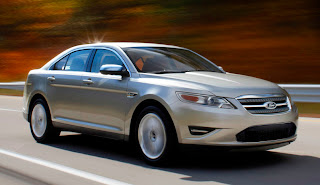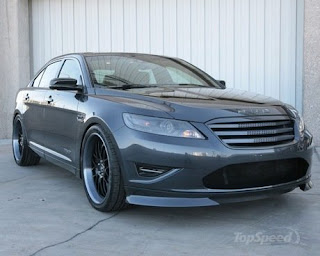The Ford Taurus is an automobile manufactured by the Ford Motor Company in the United States. Originally introduced in the 1986 model year, it has remained in near-continuous production for more than two decades, making it the fourth oldest nameplate that is currently sold in the North American Ford lineup. It has had a more upscale Mercury branded version entitled the Sable (1986–2005; 2008–2009), as well as a performance variant, the Ford Taurus SHO (1989–1999 and 2010–); in addition, it served as the basis for the first-ever front-wheel drive Lincoln Continental (1988–1994). It was a front-wheel drive mid-size car during its first production run, and it is now a full-size car available in front- or all-wheel drive. It is built on the D3 platform since 2006.
The original Taurus was a milestone design for Ford and the entire American automotive industry, as well as a very influential vehicle that brought many new features and innovations to the marketplace. Since its launch in 1986, Ford had built 7,519,919 Tauruses through the 2007 model year, making it the fifth best selling North American nameplate in Ford's history; only the F-150, Escort, Model T, and Mustang have sold more units. Between 1992 and 1996, the Taurus was the best-selling car in the United States, eventually losing the title to the Toyota Camry in 1997. The 1986–1995 Taurus was built on the DN-5 platform, 1996-1999 Taurus was built on the DN101 platform. The 2000-2007 Tauruses were built on the D186 which was a modified DN 101 platform.
In the late 1990s and early 2000s, sales of the Taurus declined as it lost market share to Japanese midsize sedans and as Ford shifted resources towards developing SUVs. It was discontinued in 2006, with production initially ending on October 27, 2006, and 2007 being the last model year. Ford had decided to replace the Taurus with the fullsize Five Hundred and midsize Fusion sedans, as well as replacing the Taurus wagon with the Freestyle crossover SUV. However, Ford revived the Taurus name during the 2007 Chicago Auto Show a few months later by renaming two new models that had been intended to be updated versions of the Five Hundred and the Freestyle, the "2008 Taurus" and "2008 Taurus X", respectively. A new model of Taurus was then released for the 2010 model year.
The first-generation Taurus was launched in 1985 as a 1986 model to strong fanfare and sales, replacing the slow-selling mid-size Ford Fairmont-based Ford LTD. (The full-size Ford LTD Crown Victoria remained as part of the Ford line up.) The release of the Ford Taurus was the one of the most anticipated ever, mostly because it was a first in-car design and also the start of new quality standard for Ford. At the time of the Taurus's debut, Ford had been producing mainly rear-wheel drive cars and Chrysler and General Motors were offering more front-wheel drive vehicles up to midrange including the Chrysler K platform and A-body Chevrolet Celebrity. With the introduction of the Escort and Tempo, Ford was making a transition to front-wheel drive. The Taurus displayed a rounder shape than its contemporaries, often likened to a 'jelly bean' or 'flying potato', inspired by the design of the Audi 5000 and Ford's own Tempo. Instead of a grille, the Taurus mainstreamed the smooth grille-less 'bottom breather' nose. The aerodynamic design of the Taurus made the car more fuel efficient, allowing Ford to meet more stringent corporate average fuel economy (CAFE) standard applied by the United States government. The Taurus's success ultimately led to an American automobile design revolution; Chrysler and General Motors developed aerodynamic cars in order to capitalize on the Taurus' success.
The first generation was available with either a V6 or an inline four-cylinder engine and came with either a manual or automatic transmission. (The Taurus's twin, the Mercury Sable, has never offered a manual transmission in either of its incarnations.) Like its exterior, the Taurus's interior was ahead of its time, and many features originating from it are still used in most cars today. Its interior was designed to be extremely user-friendly, with all of its controls designed to be recognizable by touch, allowing drivers to operate them without taking their eyes off the road. For example, the switches to the power windows and power locks were designed with one half of the switch raised up, with the other half recessed, in order for its function to be identified by touch. To further enhance this quality, the car's dashboard had all of the controls in the central area within reach of the driver. The left side of the dash curved slightly around the driver to make controls easily accessible, as well as creating a "cockpit" feel. However, it wasn't curved enough to prevent the passenger from easily identifying and using the vehicle's main controls as well.
The interior of the Taurus was highly customizable to fit buyers' needs, with a large number of options and three different configurations. This meant that the interior of the Taurus could be spartan or luxurious, depending on the buyer's choice of options. On models with an automatic transmission, the Taurus' interior was available in three different seating configurations. The interior equipment depended on model. The most basic model, the L (see below), came standard, with just an AM radio and a front cloth bench seat, while the LX, the more luxurious model, came with a greater number of features as standard equipment.
The 1986 Taurus was very well received by both the public and the press. It won many awards, most notably Motor Trend's car of the year for 1986, as well as being named on Car and Driver's ten best list for 1986. Over 200,000 Tauruses were sold during the 1986 model year, and in 1989, the millionth Taurus was sold. When production ended in 1991, more than 2,000,000 first-generation Tauruses had been sold.
The Third-generation Taurus had a presence in NASCAR, replacing the Thunderbird after the 1997 season. The Taurus became the first sedan to be approved for competition. The first Taurus driver to win the Winston Cup (now Sprint Cup) championship was Dale Jarrett, who drove #88 Ford Quality Care/Ford Credit-sponsored cars owned by Robert Yates. The first Taurus driver to win the Busch Series (now Nationwide Series) championship was Greg Biffle, who drove #60 Grainger Industrial Supply-sponsored cars owned by Jack Roush. In total, Tauruses have won three Winston Cup championships and two Busch Series championships.
The 2010 Ford Taurus was revealed at the Detroit International Auto Show in 2009 at Cobo Hall. The press preview of the Taurus and Taurus SHO was held in Asheville, North Carolina, from June 15 to June 19, 2009.
The Ford scored well in test drives and the media was pleased with some of the new features available in the 2010 Ford Taurus. Some of these features include all wheel drive, cross traffic alert, collision warning, blind spot monitoring and adaptive cruise control. However, others criticized the lack of interior room and reduced sight lines despite its full-sized exterior, and Edmunds noted that the eighth-generation Honda Accord (which competes in the midsize category) had superior driving dynamics and a more efficient design and offered almost as much interior space as the Taurus despite considerably smaller external dimensions.
The base price of the base SE model is $25,995. The mid grade SEL is priced at $27,995, and the top level Limited, at $31,995. Ford hopes to achieve a mix of 10% to 15% with its high-performance SHO model.
The Ford Taurus SHO, released in August, 2009, is the high-performance version of the Ford Taurus. The SHO is powered by Ford's new EcoBoost 3.5L V6 engine. The twin-turbocharged, gasoline direct injection power plant has 365 horsepower (272 kW) and 350 lb·ft (470 N·m) of torque. The EcoBoost V6 achieves the same fuel economy as the base 3.5L V6. The Taurus SHO base price is $37,995 which includes the EcoBoost V6, all wheel drive, upgraded 6-speed automatic transmission and numerous exterior and interior trim upgrades. A fully loaded SHO will be $45,000. There is also an optional performance package on the new SHO, which includes upgraded brake pads, a 3.16:1 final drive ratio (compared to the standard 2.77:1), recalibrated electronic power steering, further suspension tuning, a recalibrated ESC (Electronic Stability Control) with sport mode and summer compound Goodyear Eagle F1 245/45ZR20 tires, albeit to the exclusion of many feature options like Power Sunroof, Heated/Cooled Seats, Multi-Contour Seats, Auto-Sensing Lights and Wipers, Adaptive Cruise Control, Adjustable Pedals, Blind Spot Information System (BLIS), and Satellite Navigation.












